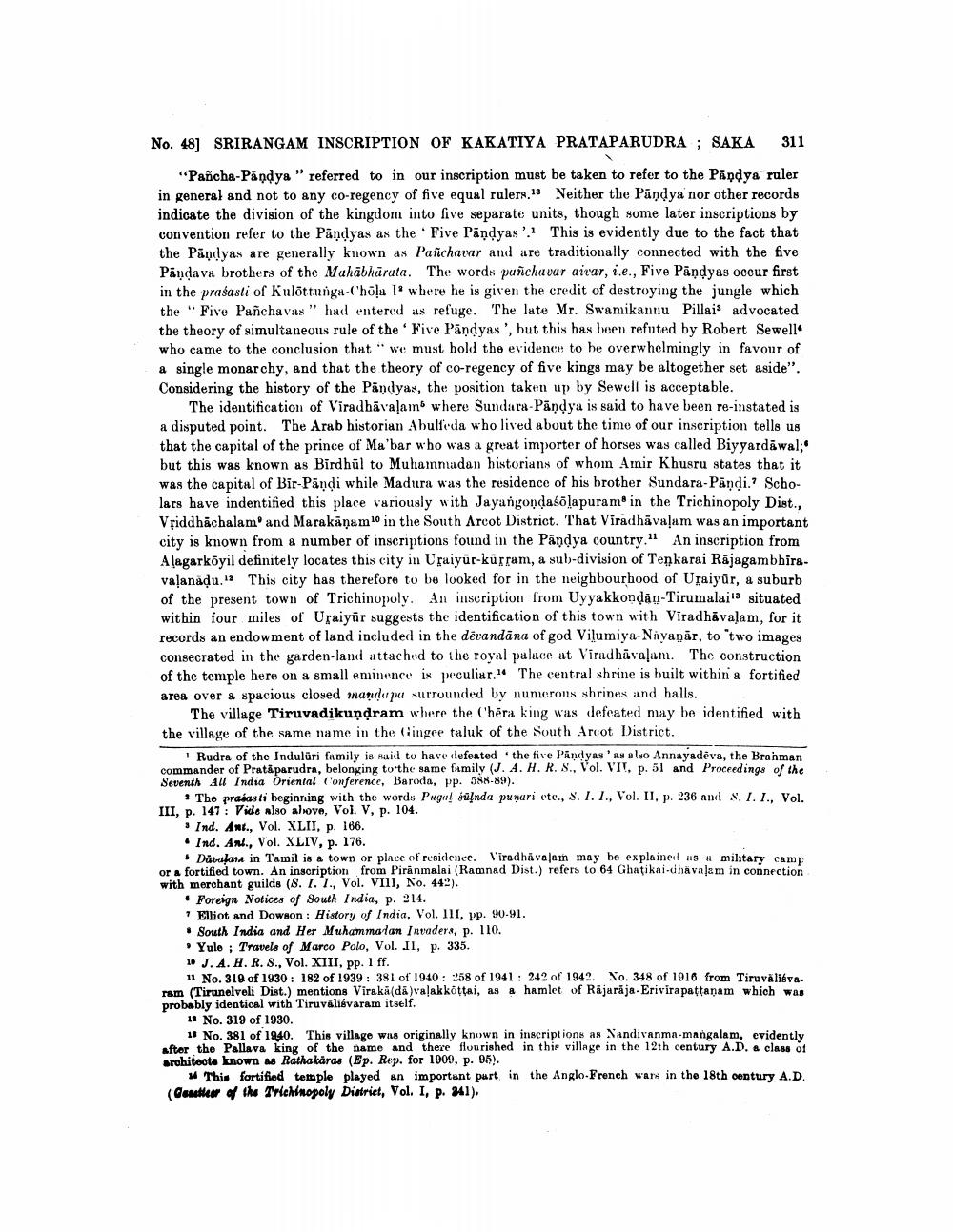________________
No. 481 SRIRANGAM INSCRIPTION OF KAKATIYA PRATAPARUDRA ; SAKA
311
"Pancha-Pandya " referred to in our inscription must be taken to refer to the Pandya ruler in general and not to any co-regency of five equal rulers. Neither the Pandya nor other records indicate the division of the kingdom into five separate units, though some later inscriptions by convention refer to the Pandyas as the Five Pandyas'. This is evidently due to the fact that the Pandyas are generally known as Pancharr and are traditionally connected with the five Pandava brothers of the Mahābhārata. The words pufichavar airar, i.e., Five Pandyas occur first in the prasasti of Kulottunga-Chöļa l' where he is given the credit of destroying the jungle which the "Five Panchavas" had entered as refuge. The late Mr. Swamikannu Pillai' advocated the theory of simultaneous rule of the Five Pandyas', but this has been refuted by Robert Sewell who came to the conclusion that we must hold the evidence to be overwhelmingly in favour of a single monarchy, and that the theory of co-regency of five kings may be altogether set aside". Considering the history of the Pandyas, the position taken up by Sewell is acceptable.
The identification of Viradhāvalam where Sundara-Pandya is said to have been re-instated is a disputed point. The Arab historian Abulfeda who lived about the time of our inscription tells us that the capital of the prince of Ma'bar who was a great importer of horses was called Biyyardāwal; but this was known as Birdhūl to Muhammadan historians of whom Amir Khusru states that it was the capital of Bir-Pändi while Madura was the residence of his brother Sundara-Pandi.? Scholars have indentified this place variously with Jayangondasolapuram® in the Trichinopoly Dist., Vriddhachalam and Marakanam in the South Arcot District. That Viradhävaļam was an important city is known from a number of inscriptions found in the Pandya country." An inscription from Alagarköyil definitely locates this city in Uraiyūr-kūrsam, a sub-division of Tenkarai Rājagambhiravalanādu. This city has therefore to be looked for in the neighbourhood of Uraiyūr, a suburb of the present town of Trichinopoly. An inscription from Uyyakkondan-Tirumalai's situated within four miles of Uraiyur suggests the identification of this town with Viradhävalam, for it records an endowment of land included in the dēvandana of god Viļumiya-Nayanār, to 'two images consecrated in the garden-land attached to the royal palace at Viradhāvalam. The construction of the temple here on a small eminence is peculiar. The central shrine is built within a fortified area over a spacious closed mandupu surrounded by numerous shrines and halls.
The village Tiruvadikundram where the Chēra king was defeated may be identified with the village of the same name in the (ingee taluk of the South Arcot District.
Rudra of the Induluri family is said to have defeated the five Pandyas 'as also Annayadeva, the Brahman commander of Pratáparudra, belonging to the same family (J. A. H.R.S., Vol. VII, p. 51 and Proceedings of the Seventh All India Oriental Conference, Baroda, pp. 588-89).
• The prasasti beginning with the words Pugal šūļnda punuri etc., 8.1.., Vol. II, p. 236 and 8.1.1., Vol. III, p. 147: Vids Also above, Vol. V, p. 104.
• Ind. Ant., Vol. XLII, p. 166. • Ind. Anl., Vol. XLIV, p. 176.
. Därava in Tamil is a town or place of residence. Viradhavalain may be explained 18 miltary camp or a fortified town. An inscription from Piranmalai (Ramnad Dist.) refers to 64 Ghatikai-chava!am in connection with merchant guilds (8. I. 1., Vol. VIII, No. 449).
• Foreign Notices of South India, p. 214. * Elliot and Dowson : History of India, Vol. 111, pp. 90-91. • South India and Her Muhammadan Invaders, p. 110. .Yule ; Travels of Marco Polo, Vol. II, p. 335. 10 J. A. H. R. S., Vol. XIII, pp. 1 ff.
11 No. 318 of 1930: 182 of 1939 : 381 of 1940 : 258 of 1941 : 242 of 1942 No. 348 of 1916 from Tiruvälisva. ram (Tirunelveli Dist.) mentions Viraka(da)valakkottai, as a hamlet of Rajaraja-Erivira pattanam which was probably identical with Tiruvilibvaram itself.
11 No. 319 of 1930.
11 No. 381 of 1940. This village was originally known in inscriptions as Xandiranma-mangalam, evidently after the Pallava king of the name and there flourished in thir village in the 12th century A.D. & class of architects known as Rathakaras (Ep. Rep. for 1909, p. 95).
This fortified temple played an important part in the Anglo-French wars in the 18th century A.D. (Castles of the Trichinopoly District, Vol. I, p. 341).




